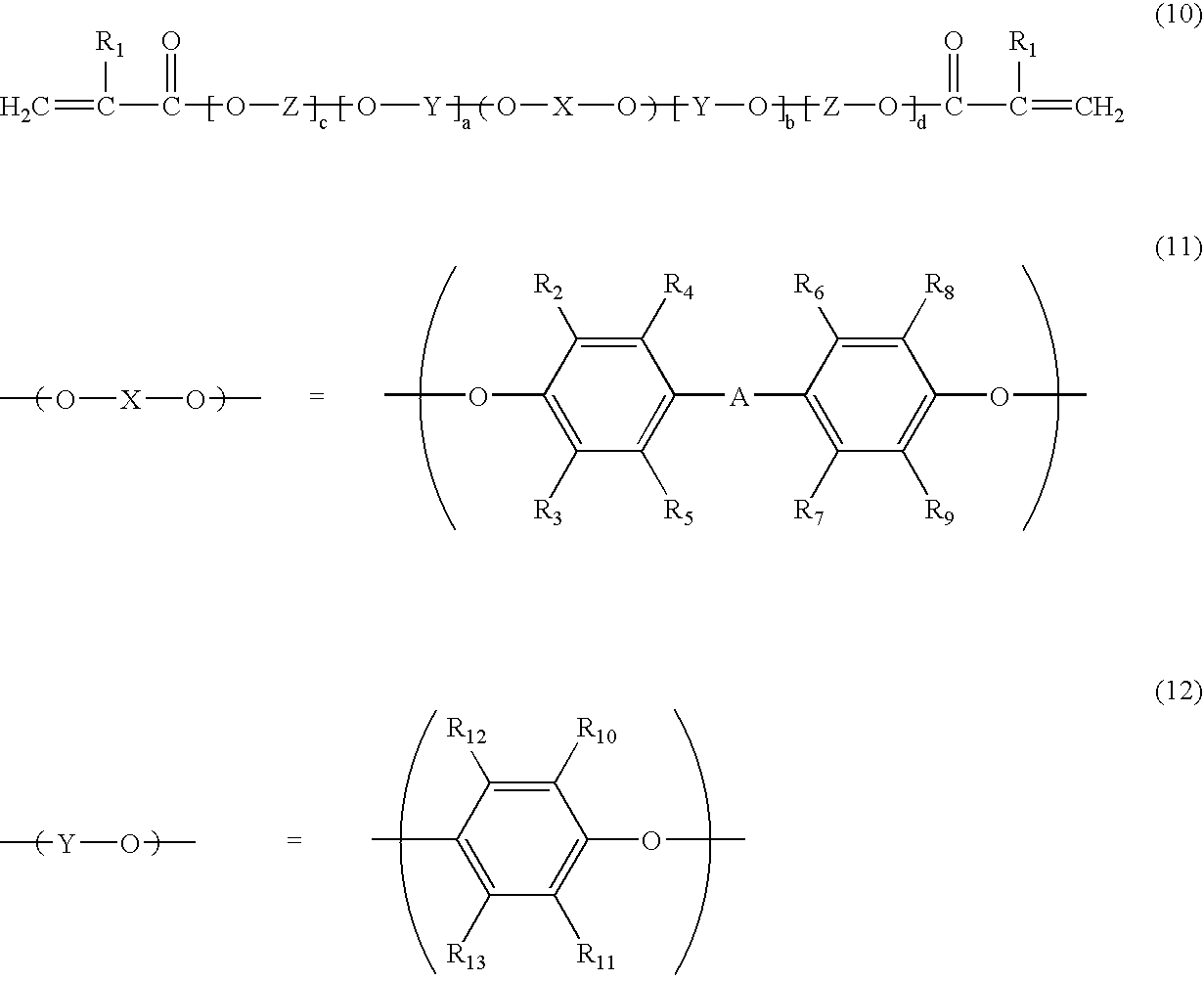Polyphenylene ether oligomer compound, derivatives thereof and use thereof
a technology of phenylene ether and oligomer compound, which is applied in the direction of metallic pattern materials, synthetic resin layered products, metal layered products, etc., can solve the problems of resin and molding processability compatibility, large decrease in humidity resistance, and inability to solve molding processability and heat resistance problems, etc., to achieve high compatibility, easy preparation, and low dielectric characteristics
- Summary
- Abstract
- Description
- Claims
- Application Information
AI Technical Summary
Benefits of technology
Problems solved by technology
Method used
Image
Examples
example 1
Production Process of Bifunctional PPE Oligomer Compound
A longitudinally long reactor having a volume of 2 liters and equipped with a stirrer, a thermometer, an air-introducing tube and baffleplates was charged with 2.7 g (0.012 mol) of CuBr2, 70.7 g (0.55 mol) of di-n-butylamine and 600 g of toluene. The components were stirred at a reaction temperature of 40° C. A mixed solution(bivalent phenol of the formula (7): monovalent phenol of the formula (8) in a molar ratio=1:2) obtained by dissolving 59.6 g (0.21 mol) of a bivalent phenol 4,4′-(1l-methylethylidene)bis(2,6-dimehtylphenol) and 50.4 g (0.41 mol) of 2,6-dimehtylphenol in 600 g of methanol was dropwise added to the reactor over 120 minutes while carrying out bubbling with 2 L / min of air. After the completion of the addition, stirring was carried out for 30 minutes while continuing the bubbling with 2 L / min of air. A disodium dihydrogen ethylenediamine tetraacetate aqueous solution was added to the stirred mixture to termi...
example 2
Production Process of Bifunctional PPE Oligomer Compound
A longitudinally long reactor having a volume of 2 liters and equipped with a stirrer, a thermometer, an air-introducing tube and baffleplates was charged with 2.7 g (0.012 mol) of CuBr2, 70.7 g (0.55 mol) of di-n-butylamine and 600 g of toluene. The components were stirred at a reaction temperature of 40° C. A mixed solution(bivalent phenol of the formula (7): monovalent phenols of the formula (8) in a molar ratio=1:2) obtained by dissolving 68.0 g (0.21 mol) of a bivalent phenol 4,4′-cyclohexylidenebis[2,6-dimehtylphenol], 25.6 g (0.21 mol) of 2,6-dimehtylphenol and 28.6 g (0.21 mol) of 2,3,6-trimethylphenol in 600 g of methyl ethyl ketone was dropwise added to the reactor over 120 minutes while carrying out bubbling with 2 L / min of air. After the completion of the addition, stirring was carried out for 30 minutes while continuing the bubbling with 2 L / min of air. A disodium dihydrogen ethylenediamine tetraacetate aqueous ...
example 3
Production Process of Bifunctional PPE Oligomer Compound
A longitudinally long reactor having a volume of 2 liters and equipped with a stirrer, a thermometer, an air-introducing tube and baffleplates was charged with 1.3 g (0.013 mol) of CuCl, 79.5 g (0.62 mol) of di-n-butylamine and 400 g of methyl ethyl ketone. The components were stirred at a reaction temperature of 40° C. A mixed solution (bivalent phenol of the formula (7): monovalent phenol of the formula (8) in a molar ratio=1:4) obtained by dissolving 42.6 g (0.15 mol) of a bivalent phenol 4,4′-methylenebis(2,3,6-trimehtylphenol) 56.7 g (0.46 mol) of 2,6-dimehtylphenol and 21.1 g (0.16 mol) of 2,3,6-trimehtylphenol in 400 g of methyl ethyl ketone and 400 g of tetrahydrofuran was dropwise added to the reactor over 120 minutes while carrying out bubbling with 2 L / min of air. After the completion of the addition, stirring was carried out for 60 minutes while continuing the bubbling with 2 L / min of air. A disodium dihydrogen e...
PUM
| Property | Measurement | Unit |
|---|---|---|
| thickness | aaaaa | aaaaa |
| temperature | aaaaa | aaaaa |
| temperature | aaaaa | aaaaa |
Abstract
Description
Claims
Application Information
 Login to View More
Login to View More - R&D
- Intellectual Property
- Life Sciences
- Materials
- Tech Scout
- Unparalleled Data Quality
- Higher Quality Content
- 60% Fewer Hallucinations
Browse by: Latest US Patents, China's latest patents, Technical Efficacy Thesaurus, Application Domain, Technology Topic, Popular Technical Reports.
© 2025 PatSnap. All rights reserved.Legal|Privacy policy|Modern Slavery Act Transparency Statement|Sitemap|About US| Contact US: help@patsnap.com



